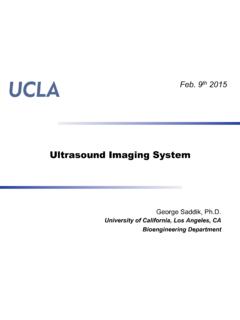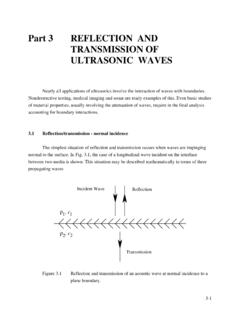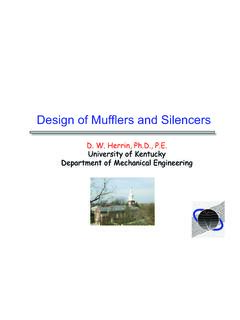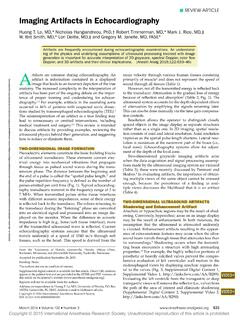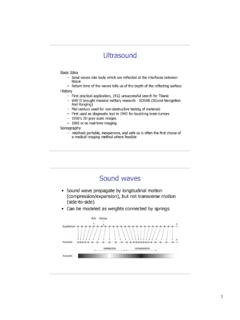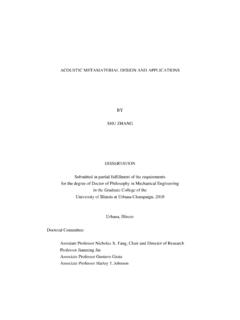Transcription of DIGEST Guidelines - Shockwave Therapy
1 2 DIGEST Guidelines To the Extracorporeal Shock Wave Therapy Updated 05/2019 Table of Contents 1 Physics and Technology of ESWT Dr. Vinzenz Auesperg p. 03 2 Practical Application Tendopathies Upper Extremities Tendinosis calcarea Radial epicondylopathy Ulnare epicondylopathy Morbus Dupuytren Prof. Dr. Ludger Gerdesmeyer Sergej Thiele Sergej Thiele Prof. Dr. Karsten Knobloch p. 20 p. 26 p. 30 p. 33 Tendopathies Lower Extremities Trochanteric pain syndrome PD Dr. J rg Hausdorf p. 37 Plantar fasciitis Achilles tendon tendinopathy Patellar tip syndrome Tibial stress syndrome Hamstring tendinopathy Morbus Ledderhose PD Dr.
2 J rg Hausdorf Dr. Martin Ringeisen Dr. Martin Ringeisen Dr. Martin Ringeisen Dr. Martin Ringeisen Prof. Dr. Karsten Knobloch p. 40 p. 44 p. 49 p. 56 p. 59 p. 62 Cartilage and Bone Arthrosis Sergej Thiele p. 65 Osteochondrosis dissecans Bone marrow edema syndrome Pseudarthrosis Stress fractures Sergej Thiele Sergej Thiele / Dr. W. Schaden Dr. Wolfgang Schaden Dr. Wolfgang Schaden p. 69 p. 73 p. 77 p. 82 Skin ESWT on the skin Prof. Dr. Karsten Knobloch p. 90 ESWT on cellulite Prof. Dr. Karsten Knobloch p. 97 Myofascial pain Therapy Myofascial pain Therapy Dr. Hannes M ller-Ehrenberg p. 102 Urology ESWT urological diseases Dr.
3 Hannes M ller-Ehrenberg p. 108 3 1 Physics and Technology of ESWT Physical Basics The Encyclopedia Britannica online ( ) definition of shock wave is "a strong pressure wave in any elastic medium such as air, water, or a solid substance, produced by supersonic aircraft, explosions, lightning, or other phenomena that create violent changes in pressure. Shock waves differ from sound waves in that the wave front, in which compression takes place, is a region of sudden and violent change in stress, density, and temperature. Because of this, shock waves propagate in a manner different from that of ordinary acoustic waves.
4 In particular, shock waves travel faster than sound and their speed increases as the amplitude is raised. Furthermore, the intensity of a shock wave also decreases faster than does that of a sound wave because some of the energy of the shock wave is expended to heat the medium in which it travels. The amplitude of a strong shock wave, as created in air by an explosion, decreases almost as the inverse square of the distance until the wave has become so weak that it obeys the laws of acoustic waves. Shock waves alter the mechanical, electrical, and thermal properties of solids and thus, can be used to study the equation of state (a relation between pressure, temperature, and volume) of any material".
5 Although shock waves have some characteristics similar to those of other waves, they differ considerably. Here these differences and similarities will be discussed. Characteristic Properties and Parameters of Shock Waves The energy of a shock wave is released as pressure on the environment. This pressure is very high, builds up extremely fast and with a classical shock wave the pressure amplitude is mainly positive pressure. The negative part is much weaker and longer and corresponds to the tension wave. The graphic should show the classical form of a shock wave, the following properties are characteristic: Extremely fast rise of the curve Very high pressure Low negative wave compared to very high peak pressure 4 Shock waves are mechanical pressure impulses which propagate in the medium in a wave-like manner.
6 To better illustrate the differences to other wave types, here is a graph showing shock waves, pressure waves and ultrasound in the same coordinates. 5 Which parameters of the shock waves are the most suitable to describe the sound fields of the devices used, is not yet completely clear today. Again and again one comes up against limits, because one cannot characterize the applied impulses with one or the other parameter. In accordance with the extracorporeal shock wave lithotripsy in urology (ESWL), the technicians of the manufacturers have especially chosen the EFD (energy flux density), the peak pressure (P) and the total energy (E) in the -6 dB focus.
7 It is now agreed that further parameters should be documented, but the process of determination is not yet complete. The following list lists the most important parameters currently in use: Positive pressure MPa -6 dB Focus mm 5 MPa Focus mm Positive energy flux density (EFD+) mJ/mm Total energy flux density mJ/mm Positive energy in -6dB focus mJ Total energy in -6dB focus mJ Positive energy in 5 MPa focus mJ Total energy in 5 MPa focus mJ Positive energy in 5 mm focus mJ Total energy in 5 mm focus mJ Finally, it should be noted here that the documentation must not only include the device used, but also the energy levels applied and the number of impulses in the individual energy levels.
8 This is the only way to retrospectively calculate a value for the total applied energy. On the homepage of the ISMST (International Society for Medical Shockwave Treatment) a In the graph it can be seen that the size of the focus is obviously very different. Some of these devices are no longer available on the market, so it is pointless to discuss their superiority, which is only noteworthy here that all devices define themselves as high- energy devices. 6 corresponding recommendation is placed, which requires the documentation of the device data and the treatment parameters. This recommendation was developed with the cooperation of DIGEST and applies to all devices equally!
9 Generation of Shock Waves The illustration shows that there are apparently very different devices. These differences are due to the different ways in which shock waves are generated. The shock waves are generated for medical applications in a Therapy head and coupled by means of a usually flexible coupling piece in the form of a membrane or a three-dimensional body. In order to achieve a suitable coupling, it is necessary to introduce a coupling medium such as ultrasonic gel between the interfaces. Otherwise even the smallest air bubbles will interfere with the propagation of the sound. Since any layer of air effectively prevents the propagation of the shock waves.
10 Electrohydraulic Generation Principle The oldest principle used in medicine is that in which the shock waves are generated by a spark plug, the electrohydraulic principle. The shock waves propagate in a medium (water) and are also focused in one place by a parabolic mirror. 7 Piezoelectric Generation Principle The piezoelectric principle is based on a focusing of pressure waves, which is produced by the electrical activation of piezoelectric crystals. The piezoelectric crystals are mounted in a shell in such a way that the pressure waves of each crystal meet in a focus. Scheme of piezoelectric shock wave generation Electromagnetic Generation Principle In electromagnetic shock wave generation the shock wave is emitted by a flat coil or a cylindrical coil by electrical pulses.
